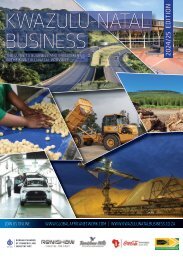South African Business 2018 edition
Welcome to the sixth edition of the South African Business journal. First published in 2011, the publication has established itself as the premier business and investment guide to South Africa, supported by an e-book edition at www.southafricanbusiness.co.za. Regular pages cover all the main economic sectors of the South African economy and give a snapshot of each of the country’s provincial economies. Feature articles on topical issues such as sustainability and African trade provide unique insights, together with an interview with the newly elected chairman of the African Association of Automotive Manufacturers, Mr Thomas Schaefer. Another special feature focusses on an exciting project to transform South Africa’s small harbours and coastal properties. South African Business is complemented by nine regional publications covering the business and investment environment in each of South Africa’s provinces. The e-book editions can be viewed online at www.globalafricanetwork.com. First published in 2011, the publication has established itself as the premier business and investment guide to South Africa, supported by an e-book edition at www.southafricanbusiness.co.za Regular pages cover all the main economic sectors of the South African economy and give a snapshot of each of the country’s provincial economies. Feature articles on topical issues such as sustainability and African trade provide unique insights, together with an interview with the newly elected chairman of the African Association of Automotive Manufacturers, Mr Thomas Schaefer. Another special feature focusses on an exciting project to transform South Africa’s small harbours and coastal properties. South African Business is complemented by nine regional publications covering the business and investment environment in each of South Africa’s provinces. Visit www.globalafricanetwork.com for more business and investment news, opportunities and events.
Welcome to the sixth edition of the South African Business journal. First published in 2011, the publication has established itself as the premier business and investment guide to South Africa, supported by an e-book edition at www.southafricanbusiness.co.za.
Regular pages cover all the main economic sectors of the South African economy and give a snapshot of each of the country’s provincial economies. Feature articles on topical issues such as sustainability and African trade provide unique insights, together with an interview with the newly elected chairman of the African Association of Automotive Manufacturers, Mr Thomas Schaefer. Another special feature focusses on an exciting project to transform South Africa’s small harbours and coastal properties.
South African Business is complemented by nine regional publications covering the business and investment environment in each of South Africa’s provinces. The e-book editions can be viewed online at www.globalafricanetwork.com.
First published in 2011, the publication has established itself as the premier business and investment guide to South Africa, supported by an e-book edition at www.southafricanbusiness.co.za
Regular pages cover all the main economic sectors of the South African economy and give a snapshot of each of the country’s provincial economies. Feature articles on topical issues such as sustainability and African trade provide unique insights, together with an interview with the newly elected chairman of the African Association of Automotive Manufacturers, Mr Thomas Schaefer. Another special feature focusses on an exciting project to transform South Africa’s small harbours and coastal properties.
South African Business is complemented by nine regional publications covering the business and investment environment in each of South Africa’s provinces. Visit www.globalafricanetwork.com for more business and investment news, opportunities and events.
You also want an ePaper? Increase the reach of your titles
YUMPU automatically turns print PDFs into web optimized ePapers that Google loves.
OVERVIEW<br />
Manufacturing<br />
Large incentives are available to investors in manufacturing.<br />
SECTOR INSIGHT<br />
The Manufacturing Circle<br />
aims to create one-million<br />
jobs.<br />
• The structural mill at<br />
Evraz Highveld is working<br />
again.<br />
The Manufacturing and Competitiveness Enhancement<br />
Programme (MCEP) of the National Department of Trade and<br />
Industry (dti) announced in 2017 that it had disbursed a total<br />
of 1 552 grants to the value of R5.8-billion which had resulted<br />
in 230 000 jobs being “sustained”. Plastics, pharmaceuticals and<br />
chemicals received 31% of the money, metal fabrication, capital and<br />
real transport equipment 28% and agri-processing 21%.<br />
Italian forged wheel manufacturer Lucchini received tax and<br />
training allowances from the dti which helped it decide to invest<br />
R200-million in a new forged wheel-making facility. Blank railway<br />
wheels imported from Italy will be completed at the Germiston plant.<br />
Industry support from the state is necessary because the manufacturing<br />
sector’s contribution to the national economy has slipped<br />
to below 13% from a high of 24% in the 1980s. This is according to the<br />
chairperson of the Manufacturing Circle, as reported in Engineering<br />
News. Andre de Ruyter added that if the percentage could be<br />
brought to 30%, the sector could contribute up to one-million<br />
more jobs. The Manufacturing Circle is in talks with government<br />
about how to improve policy to bring this about.<br />
The sector that has done best since 1994 in terms of growth is<br />
the automotive sector, followed by resource-based manufacturing.<br />
The latter sector includes steel, aluminium, petrochemicals, paper<br />
and pulp, and non-metallic minerals.<br />
Among other important sectors<br />
are metals beneficiation<br />
(more than 50% of the world’s<br />
ferrochrome is produced in <strong>South</strong><br />
Africa), coke and refined petroleum<br />
products, and information<br />
and communication technology.<br />
Steel and petroleum collectively<br />
make up about 45% of <strong>South</strong><br />
Africa’s total manufacturing<br />
production capacity.<br />
Steel has been experiencing<br />
a volatile few years, with<br />
reduced demand from China<br />
severely reducing production<br />
volumes in <strong>South</strong> Africa. The<br />
Steel and Engineering Industries<br />
Federation of <strong>South</strong>ern Africa<br />
(Seifsa) reported that 19 000<br />
jobs were lost in the metals and<br />
engineering sector in the nine<br />
months to September 2016. This<br />
sector makes up 28% of manufacturing.<br />
Cheap imports have<br />
been at the heart of problems for<br />
the steel sector, as they have for<br />
textiles, but other issues include<br />
energy prices and labour costs.<br />
SOUTH AFRICAN BUSINESS <strong>2018</strong><br />
94


















